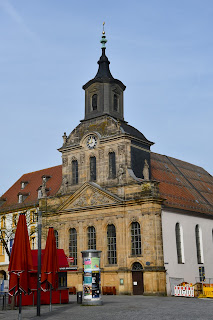Germany Trip – Day 2: Bayreuth and Würzburg
If the combination of Bayreuth and Würzburg seems a little strange, then congratulations on knowing a lot about North Bavarian geography. Snark aside, I do admit that had this combination of destinations been planned, it would have been a silly plan indeed, especially seeing as Bamberg (which I visited yesterday) lies right between the two cities. It would have made much more sense to visit Bayreuth and Nuremberg on one day, and Bamberg and Würzburg on the other. However, I got myself into this situation entirely by accident: I toured Nuremberg and Bamberg much faster than I thought I would, leaving myself a whole day to fill somewhere else.
I decided,
therefore, to make a morning visit to Bayreuth, a town most famous for its
connection to Richard Wagner. A native of Leipzig, the composer was lured to
Bayreuth by the promise of being able to conduct at the Margravial Opera House,
one of the largest performance venues in Germany at the time. However, the
building was still not large enough for the likes of Wagner, so he decided to
construct an entirely new one on a nearby hill. Reading this story at the
Margravial Opera House did not surprise me in the slightest. Wagner was
well-known for his conceit and megalomania; when he was a child, he subjected
his entire family to endless performances of his own soliloquys.
After
arriving in Bayreuth, I toured the old town centre and walked around for a
while before visiting the palace gardens. These quiet, verdant haunts
surrounding the local stream lie right by Wagner’s house and museum, which of
course stand right behind an enormous family tomb. The visit to the Margravial
Opera House was quite interesting, though it is unfortunate that tourists do
not get to walk up to the upper floors of the theatre. The museum does,
however, have other attractions, such as a 1:4 replica of the mechanism used to
change sets and move objects in the background.
Wagner’s
Festival House is a twenty-minute walk from the old town, and I would have
skipped this attraction had I not learned about the comical history I just
related. That being the case, I hiked there and straight back to the train
station, where I caught the next train back to Nuremberg. There, I ate a quick
lunch before boarding another train to Würzburg, arriving just before two
o’clock. Strangely, the ticket price I was given on my DB app was 10 euros more
expensive than the price given by the ticket machine – a stark difference.
Würzburg
strongly reminded me of Prague. Both are cities built on a riverbend, with
castles on one side and an old town on the other, the two sides connected by a
hefty bridge with statues of saints. The name Würzburg comes from the Latin Uburzis,
which itself is likely derived from a Celtic word. However, folk etymology
forged a connection with the word Würze (herb), which is why the town’s
medieval Latin name was Herbipolis.
















































Comments
Post a Comment